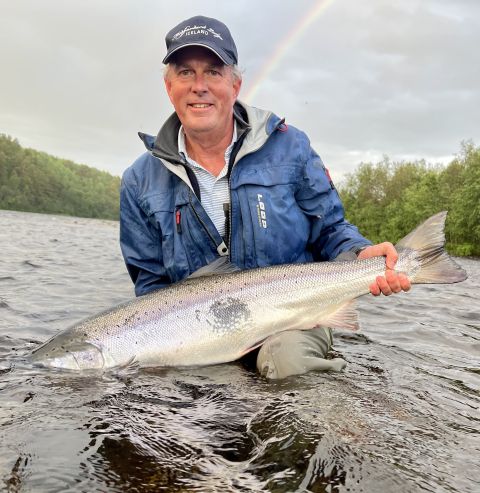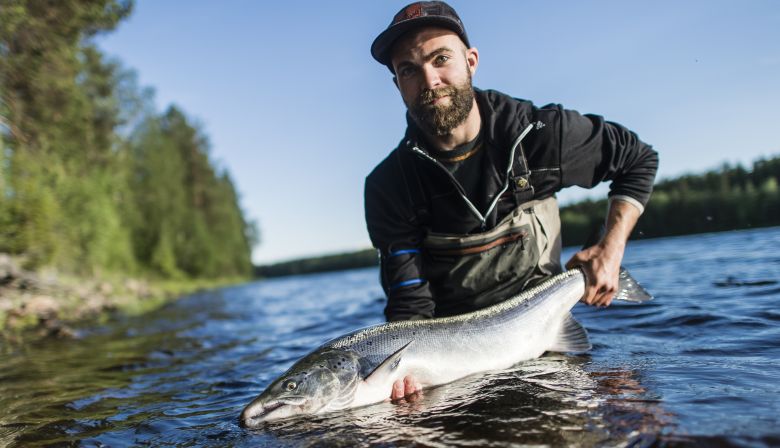
Subscribe & stay up-to-date with ASF


– Bill Taylor, President | Atlantic Salmon Federation
Bill rose this beautiful specimen (pictured below) seven times on a variety of flies, before the temptation of a Carter’s Bug was too much for it to resist. A slow motion downstream take and acrobatic fight, ended with a brief revival and smooth release.
Watch the video until the end to see this stunning salmon release in crystal clear waters. It takes a brief rest before taking off explosively — like a shot from a cannon. Perfection!
Bill Taylor releasing an acrobatic Atlantic at Big Eddy Pool on the Petite Cascapédia | Video: Robert Bentwell
We just wrapped up a spawning and juvenile rearing habitat project on Howell’s Brook (a major tributary to the West River) last week. This project began with the assistance of ASF’s Kris Hunter, as we walked and identified the sites on May 30th.
We received approximately ~10 tonnes of spawning rock to place in areas used by Atlantic salmon for creating redds and 15 tonnes of gabion rock (R5) to place in riffles downstream of spawning areas to help improve juvenile rearing habitat. In total 13 spawning sites and 18 riffles were enhanced along a 600m reach of Howell’s Brook.
By providing high quality spawning substrate free of fine sediments, we hope that Atlantic salmon redds will have increased embryo survival which we anticipate will translate into an increase in juvenile recruitment. Juveniles will also have an abundant amount of coarse substrate in riffle areas to grow and thrive for the first two years of their lives. Our group aims to ensure each life stage has the necessary components in order to be successful and that our rivers are able to support healthy local populations of Atlantic salmon.
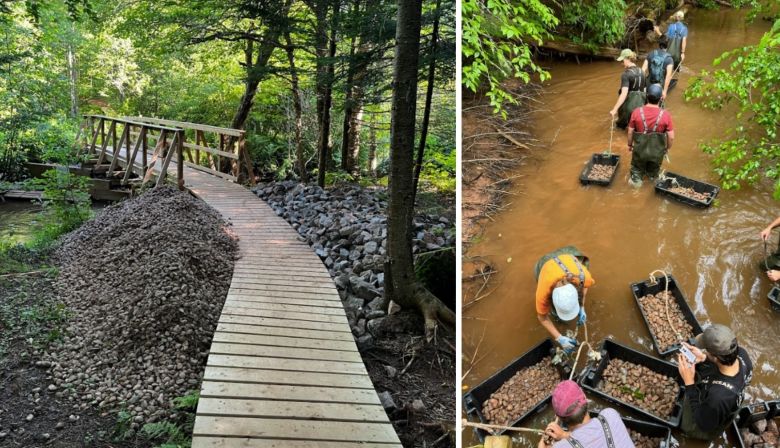
The fish kill was localized to the section of the East Branch known as “The Everglades”. Close to 300 brook trout were recovered, many of which in the 3 to 5-pound range. No Atlantic salmon were found.
For more details see: CBC News Article | ‘Combination of factors’ likely led to fish kill.
Although it will be awhile before the official findings are released, provincial officials noted that high water temperatures and water oxygen levels approaching zero were observed in the area of the kill. Angling has been restricted in the East Branch for the remainder of the season.
Despite PEI’s small spring fed brooks remaining largely cool throughout the summer months, elevated water temperatures are an issue in a number of watersheds throughout the province. This is especially true for those with dark tannin-stained waters and a large number of man-made impoundments. The Morell is one such river where water temperatures are known to reach, and at times exceed, 25°C in the main river. Beaver impoundments and an explosion in aquatic growth in recent years have worsened the issue.
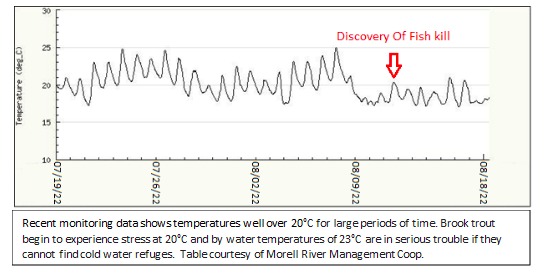

With the summer winding down, we will soon be into fall angling, arguably the best time to be on the water in PEI. Trophy brook trout often approaching four or five pounds can be targeted until September 30th this year, while Atlantic salmon and steelhead may be targeted until October 31 and December 31, respectfully, on some rivers. Although multi-sea winter salmon approaching 18lbs have been encountered, grilse all the way up to 12lb are the most common. A good steelhead on the other hand typically ranges between 4 and 7lbs. Not unlike other years, a small number of summer salmon were observed on the Dunk, West and Morell Rivers. However, our main run occurs well into October and throughout November.
Water levels are not critically low as we have seen in recent years. Brook trout fishing was noted to be slower on the Morell River this June, but trout are reported to be more plentiful on other systems. Steelhead fishing continues to pay dividends in places like the Montague, Valleyfield, Dunk and Wilmont Rivers, among others.
The Chéticamp River Salmon Association (CRSA) extends their thanks and best wishes to an integral member of their team:
We’re saying goodbye to a great one this week! Friday will mark the end of Aaron Krick’s 4th summer with the CRSA, and his first year leading our field crew. We can’t say enough good things about Aaron, so let’s just say this – Aaron has been an incredible team player and role model, the most passionate angler and conservationist, and just a real positive force on the CRSA team. Thanks for the great work, dedication, and all the good memories, Aaron! We will look forward to seeing you, one way or another, next year!
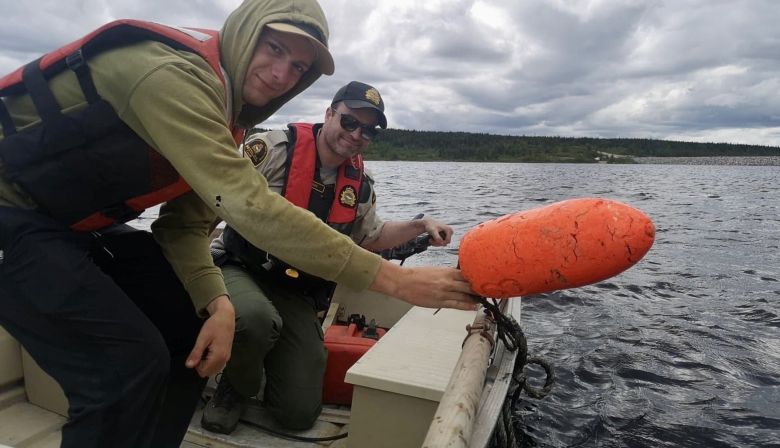
As Aaron Krick packs for his journey home to Ontario, he shares:
As I prepare to head home next week, I reflect on another great summer in Margaree, with plenty of fish and good times on the river. The season started strong and kept up into mid July…unfortunately the wheels fell off in late July as the heat arrived, the lower river closed down, and the hot summer weather never consistently loosened its grip as it remains closed. But the disappointing end of the summer can’t cloud the stellar early season. There were lots of salmon in the 10-14lb area, however larger fish were few and far between this year. Hopefully it’s a great fall season, I know I’ll be looking forward to next June.
From your friends at ASF and on the river — Thank you Aaron for your enthusiasm, hard work and passion on behalf of our beloved Atlantic salmon. We wish you all the best in the months and years to come!
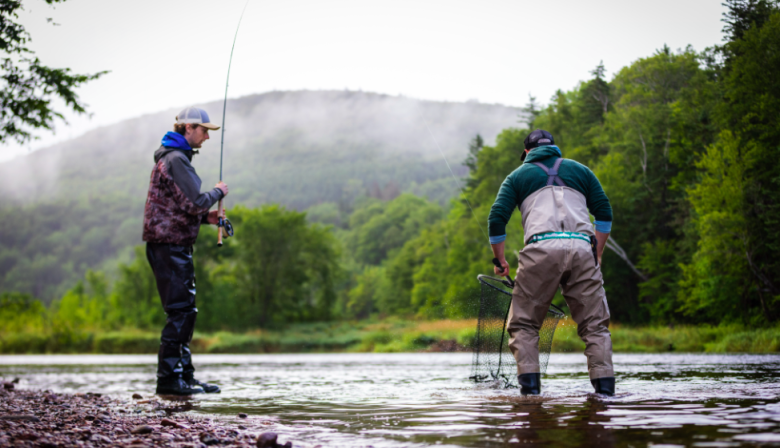
It was a turbulent spring and summer season in Nova Scotia with clustered rain events, followed by weeks of drought-like conditions. Most rivers in my area were open by May 15th.
Early season angler observations concluded a healthy population of kelt exiting the river to make their way back to Greenland. This was quite noticeable in the Pictou County and Antigonish river systems.
While I had some luck connecting with sea run browns and Speckled trout, I would say most of these fish left the river early and congregated deeper into the estuary. Water temps in April and early May were fairly cool, and as we know these trout like to target smaller bait fish. With the cooler temps, the bait fish (mummichogs) did not appear to enter the lower river when expected, thus the sea trout stayed in estuary coves a bit longer.
Striped Bass continue to be a topic of discussion among anglers. In the past two seasons, I have hooked them as early as April 15th and this season was no different. It is common to hook a striper while targeting trout. Stripers appear in the lower section of Lower South and West River Antigonish early and often. Angler reports indicate they had made their way upriver as high as the No. 7 salmon pool (West River) by early June. Based on the abundant population of schoolies appearing in April, I would guess Striped Bass do not leave Antigonish harbour and may remain year-round. Based upon angler observation alone, I am of the opinion that the population growth we have experienced is having an impact on our trout fishery throughout the North Shore rivers.
In the 2nd week of June we had favourable water conditions in Eastern and Northern NS rivers. Several back to back rain events created a good rise in water and fish utilized this window to quickly move upstream. Trout fishing was excellent and anglers had good luck throughout the rivers.
The rivers of Eastern Nova Scotia are where I cut my teeth as an angler. Growing up on the banks of Country Harbour river as a kid, fishing was a great past time. Each season I always go back to those spots that hold such great memories. Water conditions in the area were quite low in the spring. There was very little snow melt, and the spring rain did not amount to much. From mid-June to the second week of July, water conditions improved and so did the fishing. Sea trout entered the rivers and there was some excellent fishing to be had. Atlantic salmon were also observed making their way upstream. Leaps of shiny silver Atlantic Salmon often created some excitement within the pools and fostered an optimism that these fish will continue to come back, despite the challenges they face. Atlantic Salmon were observed on three rivers I visited during this time.
Although the fishing conditions were promising for a 3-4 week period on Eastern NS rivers, water levels dropped dramatically and precipitation in the forecast became less frequent. By the middle of July fishing conditions were not favourable as air temps increased and water levels decreased. This hot and humid weather continued into August. During dry conditions, I put the fly rod away and walked several rivers with my camera in hand. Atlantic Salmon, brookies and browns were spotted in deeper pools and often the fish were nosed up against any flowing water, where available.
At present, air temps have dipped sightly however, water conditions are still very low. I am looking forward to the fall Atlantic Salmon season and my fingers are crossed for improved water conditions with lower air and water temperatures.
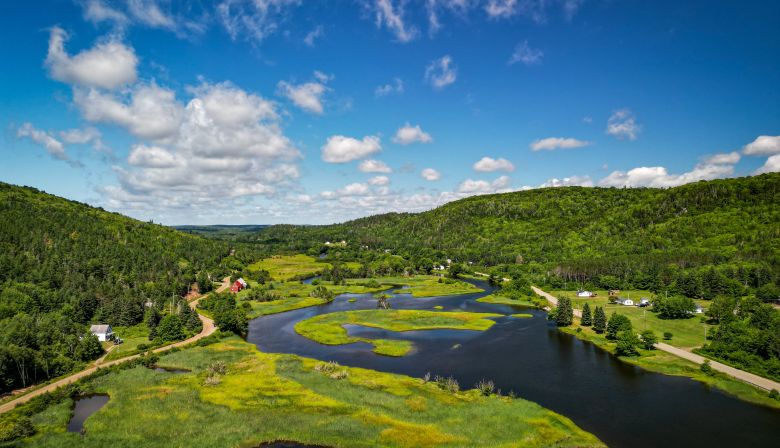
ASF has been working with with Maine Department of Marine Resources to electrofish in Orbeton Stream, a tributary of the Sandy River where DMR plants eggs. The stream has many pockets of cold water, and black nose dace and salmon parr were predominant.
We have also worked with Maine DEP to monitor water quality above and below the former impoundment at Walton’s Mill Park. A temporary increase in turbidity was observed downstream when the dam was removed, and small increases were observed during the subsequent stream bank stabilization. This is expected to continue as sediment from above the former impoundment shifts downstream. The effects of the dam removal were also seen upstream, where deep pools are now much less stratified.
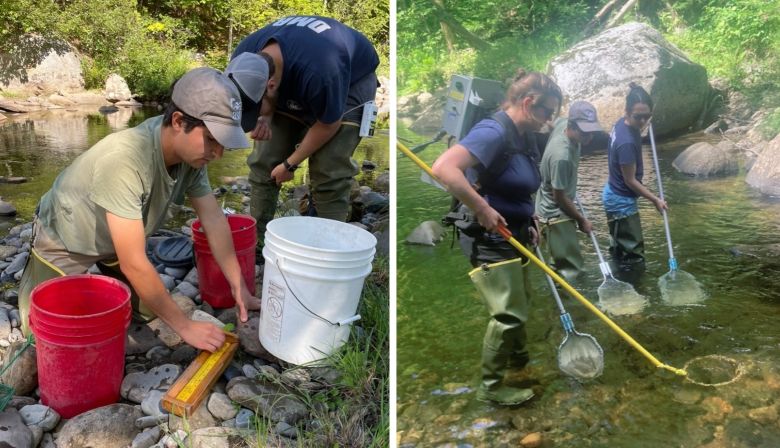
The annual maintenance of the Milford Fishway occurred August 1st to 3rd. The fishway has been in operation since. Only a couple fish have been captured during these very warm past few days. When the river holds 27.7C overnight like it did on August 8th, salmon are not happy fish! The good news is that with the much needed rain we just had and the recent cool nights, the river dropped back down to 21.8C this morning.
Penobscot River Update | August 18th, 2022
Stay tuned for the next update in early September. We are hopeful for cooler temperatures and for fish to be moving by that time.
Lower Mainstem Kennebec – Temperatures remained warm on the mainstem Kennebec throughout most of this past week, averaging around 24°C. Thanks to the Nor’easter that came through Maine on Wednesday/Thursday, the temperature on the mainstem decreased to 22°C and the flow level in Sidney, ME is currently at 4,720 cfs and increasing. The discharge level is now between the mean and 75% of historic discharge levels – based on 36 years of data. See: USGS current conditions.
The fish lift has been fully operating over most of the past week. No Atlantic salmon were captured since the last report.
Electrofishing juvenile assessments have begun in the Sandy River as of 8/10. To date 12 sites have been completed and have all contained juvenile salmon. All sites are in the mid/upper mainstem Sandy and its tributaries: South Branch Sandy River (and tributaries), Valley Brook, Perham Stream and Orbeton Stream.
Following are images of wild young of the year salmon and parr, a site in Orbeton Stream, adult salmon holding in a pool just downstream of one of our sampling sites, and measuring the fork length of a live parr.
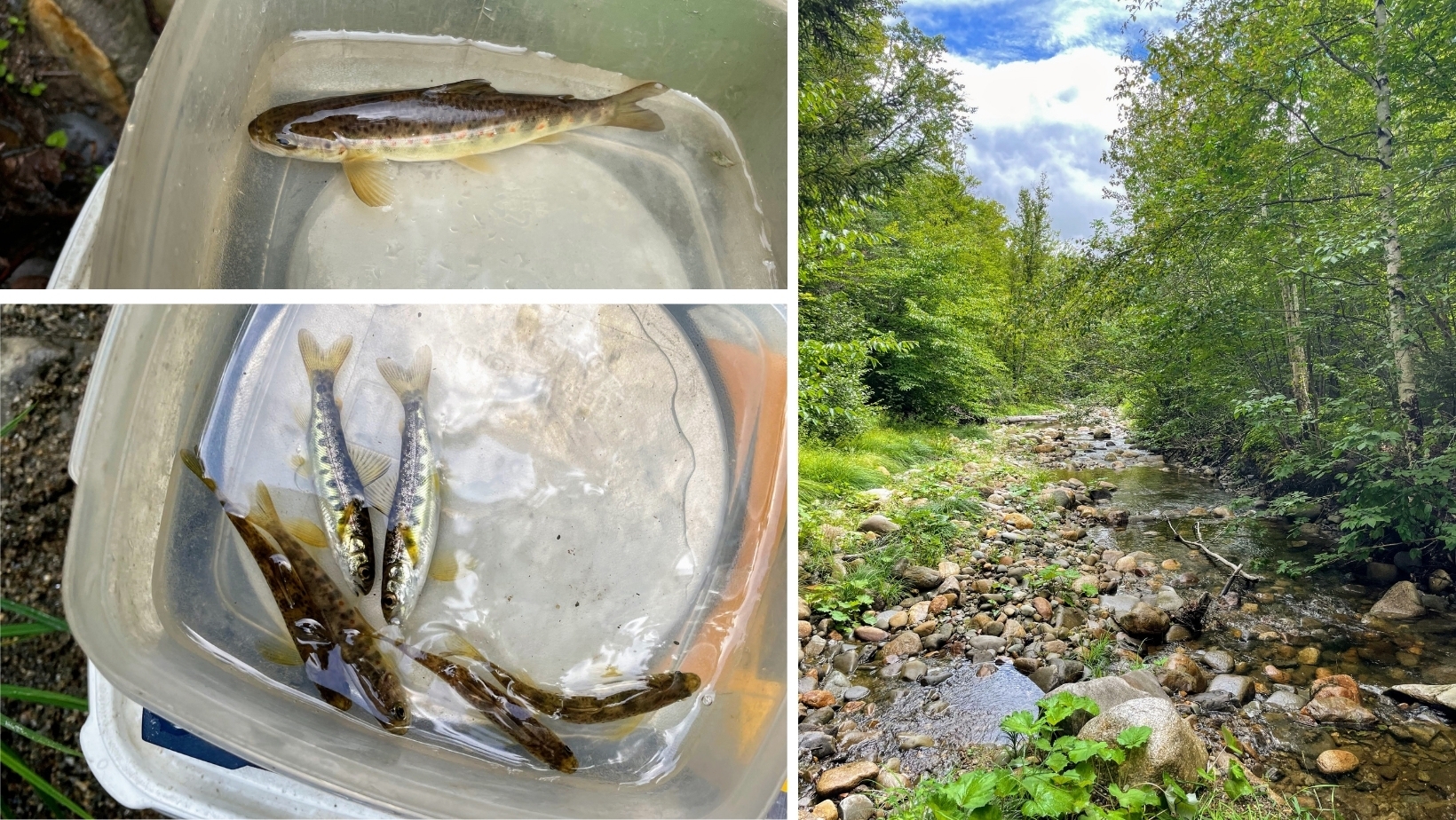
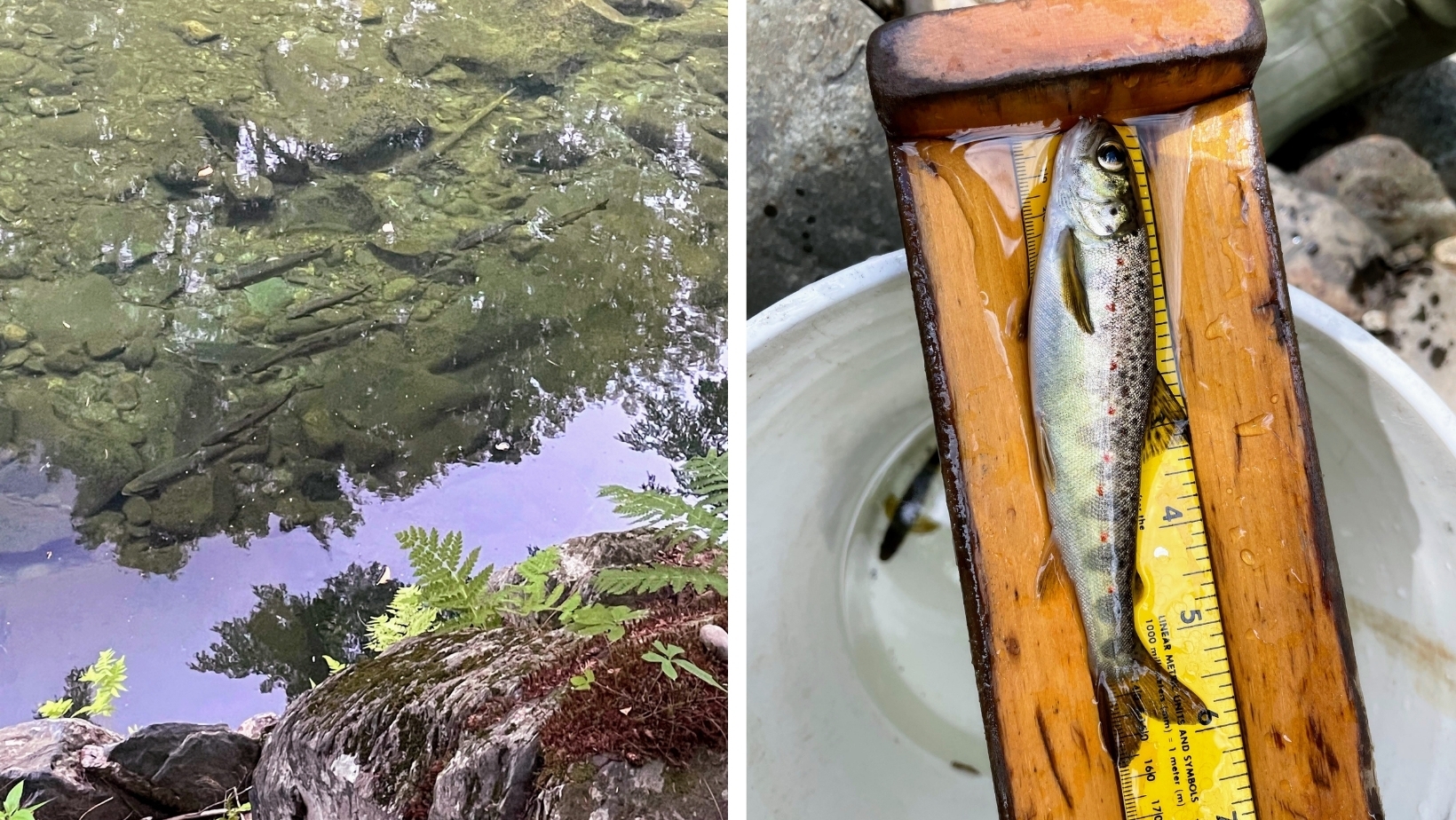
Stock enhancement/beach seine project updates by Craig King – from the Kennebec and beyond:
This week we are wrapping up our third round of lower river beach seine sites, as well as our third round of upper river sites. Today, we have a 100% completion on all sites. It makes 84 complete same sites for 2022 to date. This past week rainbow smelt showed up in our lowest river sites for the first time for 2022. We continue to get a few juvenile shad and herring in our sites but have yet to get any juvenile striped bass. Today, we are working in conjunction with the U.S. Navy and University of Maine Orono to tag more sturgeon of both species to monitor movements in the lower Kennebec drainage.
Androscoggin River (provided by Brookfield) – The upstream fishway was closed all week for annual inspections and maintenance.
– Brunswick fish lift (mainstem Androscoggin) total catches for 2022 (as of 8/15): 17 Atlantic salmon
Due to warm water temperatures and low levels, fishing has been very slow these last two weeks on most rivers on the Island of Newfoundland. As a result, very few anglers have been fishing. The poor river conditions have also resulted in DFO restricting angling to early morning hours on many rivers throughout the island portion of the province.
See the latest DFO River Openings and Closures for NL.
Late last week, sporadic rain caused water levels to improve on rivers in the Southwest corner of the Island, as well as on some rivers along the Northeast coast and Avalon Peninsula. As such, many rivers in these three locations were reopened for all day angling. I have received reports that a few fish were hooked at this time. However, the rain was followed by more hot and dry weather, fishing has once again slowed. While there is still a good sign of fish on the lower section of a few rivers on the island, by now salmon on most rivers have reached headwater sections.
In Southern Labrador, we are also seeing warm, low conditions. However, there is still a good sign of fish on many rivers in this area. Lately, overnight temperatures have been dropping down to the low teens which is helping to moderate the warm water temperatures in this region. This, along with forecasted rain, should help to improve angling conditions during the next week or so on rivers in southern Labrador.
In Northern Labrador, river conditions have been more favourable during the past two weeks, and reports indicate that anglers are still enjoying some decent fishing on rivers in this region.
See the latest DFO Fishway Counts for NL.
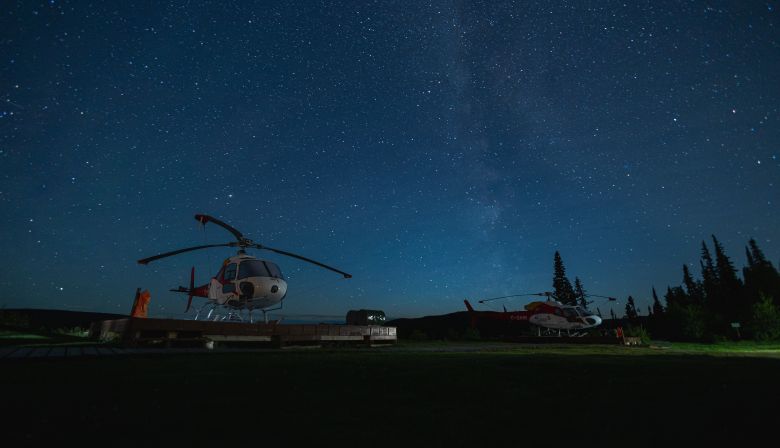
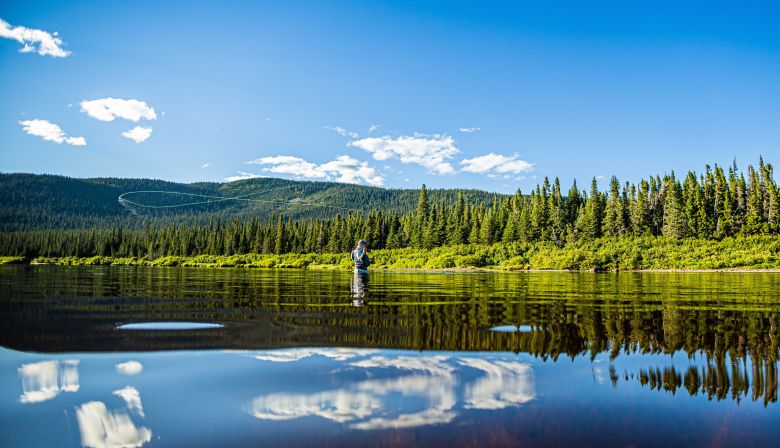
Regional Round-up
Southwestern NL – With the exception of a day or two during the past two weeks, water levels have been low on all rivers in Bay St. George and water temperatures have been warm. For example, Harry’s River is currently running at just 13 c/m/s and the water temperature during the day ranges between 18-24 degrees Celsius. As one would expect, fishing has been very slow.
Western NL – Again, water levels on most rivers in this area have been very low and water temperatures have been very warm during the past couple of weeks. There are still a few fish at Big Falls but fishing has been very slow, with early morning fishing producing the best results. Most fish have now reached the upper regions of the Humber River. On the lower Humber water levels have been much better but water temperatures are still on the warm side. Still a few fish are being caught in this section of the river including a 16-17 pounder released by Lenny Boone late last week.
On Main River (Sops Arm) rain on Aug 20th cause the water level to rise from 12.5 to 24.0 c/m/s. As a result, a few fish were being hooked in the upper portion of this river, with most success being had during early morning hours when water was cooler.
Northern Peninsula – Water levels and temperatures have been a little better on the Northern Peninsula during past couple of weeks. Marvin Thatchel reports that there is still a good sign of fish on Castor River and his clients are reporting success. Likewise, brothers Monty and Ryan Way report that they hooked several fish on a recent trip to Main Brook (Salmon Brook).
Labrador – Dwight Lethbridge, owner of Pratt Falls Lodge, reports that currently water levels (at 200 c/m/s) is ideal for fishing on the Eagle River. He reports that there is still a good sign of fish in the river. While he has finished operations at his lodge for the season, he reports that a group of five anglers fishing at the Lower Eagle Club (just down river) reportedly had a very successful week.
Tony Chubbs, with the Labrador Hunting and Fishing Association, reports that along with a few fishing companions, fished Kenamu River a week or so ago, and between them they saw about 12 fish. They released a 14-pound hen and lost another large in 10 to 12-pound range. They also hooked and lost two grilse. The water level was a little high at the time and the water temperature was 15C.
Central NL – Angler, Maureen Hawco reports that she recently fished Terra Nova River (above TCH) for four days, during which she only saw one fish. The water level was very low at the time and the water temperature was warm. There were no fish moving through.
Angler, Trevor King reports that he fished the lower Gander River recently and the river was very low and warm, making for poor fishing conditions. However, he reports that there was a great show of fish in the area at the time.
Meanwhile, reports indicate that there are very few fish being seen on the lower Exploits River, again due to summer conditions.
Avalon Peninsula – Water levels on most Avalon Rivers have been very low and warm. Rain late last week caused water levels to rise briefly, during which time the odd fish was hooked but fishing remains very slow.
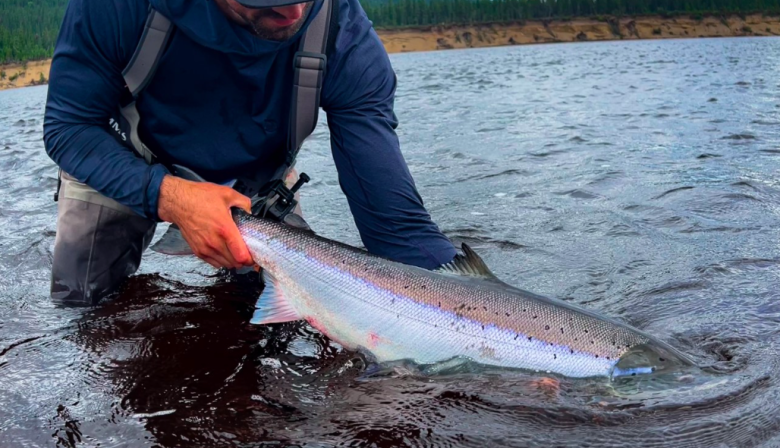
ASF Director, Edward L. Shugrue III shares:
In early August, the Hunt River in Labrador, had very high water levels and record returns, with a nice mix of salmon and one sea winter (65cm) warrior and acrobatic grilse.
Chris and Jen Verbiski, owners of the Hunt River Lodge, have an active and ongoing salmon tagging program from their lodge. Most salmon are tagged and the data collected is meticulously recorded. Their tagged fish have been found around the oceans, including Greenland.
After a brief tuition, anglers can assist the guides is tagging the fish. It’s an extra bonus to the splash from their tail after a healthy release. To many happy returns!

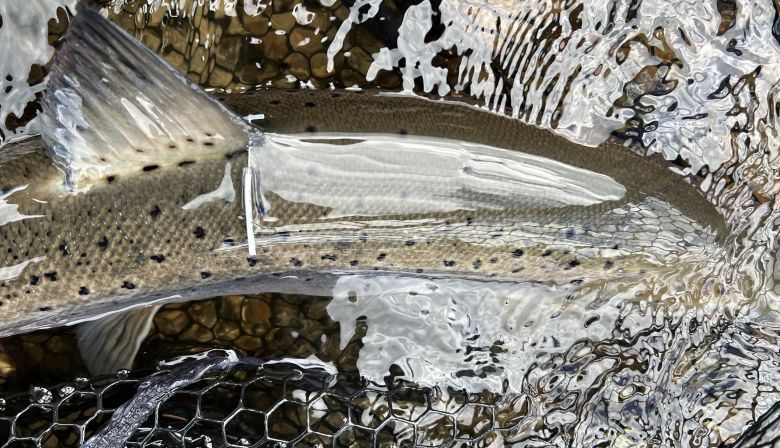
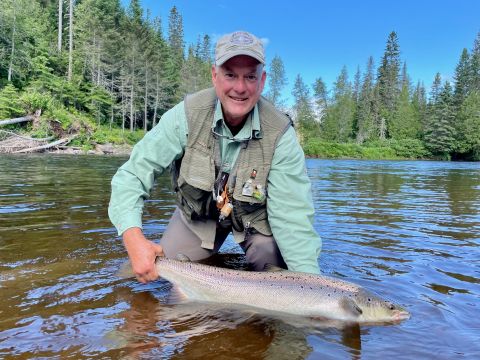
Échos des rivières pour le 25 août 2022
Charles Cusson, Directeur québécois, Fédération du saumon atlantique.
Même s’il y a eu un peu de précipitation dans certaines régions, les conditions des rivières sont toujours extrêmement basses et les températures demeurent élevées sur la plupart des rivières.
Pour l’instant, les gestionnaires ne détiennent aucune mesure légale qui leur permet de fermer une rivière pendant des périodes de température trop élevée. Un protocole d’eau chaude est présentement à l’étude par le gouvernement.
Les conditions d’eau plus chaude étant la norme en ce moment, veuillez svp réduire au minimum la durée du combat si vous piquez un saumon et veuillez les garder le poisson dans l’eau pendant tout le processus de la remise à l’eau. Il n’y a pas de temps prédéfini pour relâcher un poisson, il vous indiquera quand il est prêt à partir.
Rappel aux saumoniers pêchant les rivières du Québec, prenez le temps de rapporter vos prises et remise à l’eau afin d’avoir des statistiques précises et que les gestionnaires de rivière puissent calculer le succès de pêche avec précision.
Tight Lines !
** Les données utilisées dans ce rapport proviennent de divers sites Web, médias sociaux et des sources du gouvernement du Québec.
Rivière Cascapédia
Les résultats sont très bons considérant les conditions plus difficiles pendant la deuxième moitié du mois de juillet.

Rivière Nouvelle
Renommée pour sa population d’omble de fontaine anadrome, cette petite rivière qui se déverse dans la Baie des Chaleurs connait une saison remarquable. Les pêcheurs sportifs font rapport au 19 août que 108 poissons (toutes grandeurs confondues) ont été capturés. La remise à l’eau des grands saumons est obligatoire. Pendant la saison 2021 se terminant le 30 septembre, 12 saumons furent graciés et 4 madeleineaux ont été récoltés.
Rivière de la Trinité
La Zec de la Baie-Trinité fait rapport qu’au 22 août que 452 poissons ont franchi la passe migratoire depuis le début de la saison 2022, dont 260 saumons et 192 madeleineaux.
Pour la saison 2021 au 30 septembre, 868 poissons avaient été dénombrés, dont 98 saumons et 770 madeleineaux.
Rivière Bonaventure
En 2022, cumulativement au 20 août, 1 321 poissons ont été enregistrés comprenant 995 saumons relâchés et 326 madeleineaux récoltés.
Comparativement jusqu’au 21 août 2021, 659 saumons avaient été relâchés et 428 madeleineaux récoltés pour un total de 1 087.
Rivière Matane
En considérant les débits excessivement bas à ce stade de la saison, le décompte de la Matane maintient un rythme respectable.
En date du 22 août, 1 164 saumons et 1 014 madeleineaux ont été cumulativement comptés pour un total de 2 178. Les pêcheurs sportifs ont déclaré la capture de 562 poissons, dont 188 saumons et 74 madeleineaux remis à l’eau ainsi que la récolte de 45 saumons et 255 madeleineaux.
Au 23 août 2021, pour la saison, 2 165 poissons avaient été dénombrés dont 890 saumons et 1 275 madeleineaux. Cumulativement au 23 août 2021, 2,397 poissons avaient été dénombrés, dont 1 540 saumons et 857 madeleineaux. Du côté de la pêche sportive, 690 poissons avaient été capturés (158 saumons et 134 madeleineaux relâchés, 45 saumons et 353 madeleineaux récoltés).
Au 23 août 2020, 588 poissons avaient été capturés, dont 219 saumons et 61 madeleineaux relâchés. De plus, 75 saumons et 233 madeleineaux avaient été récoltés.
Rivière Madeleine
La rivière Madeleine est située sur le côté nord de la péninsule gaspésienne et possède une passe migratoire très spéciale qui a été conçue dans les années 1960. Elle est creusée dans la montagne à côté de la cascade naturelle que les poissons ne peuvent pas franchir. Le regretté Wilfred Carter, président émérite de la FSA était impliqué à l’époque dans ce projet comme employé du gouvernement du Québec.
À ce qui a trait de la saison courante au 22 août, 1 641 poissons ont été dénombrés, soit 1 069 saumons et 572 madeleineaux.
Cumulativement au 24 août 2021, 1 626 poissons avaient franchi la passe migratoire, soit 747 saumons et 849 madeleineaux.
Rivière Matapédia
La CGRMP, corporation qui gère les rivières Matapédia, Patapédia et Causapscal déclarent que 645 poissons ont été capturés cumulativement au 22 août, dont 412 saumons relâchés et 233 madeleineaux récoltés.
En date du 23 août 2021, les pêcheurs sportifs avaient déclaré la prise 583 poissons, dont 325 relâchés et 258 récoltés.
À la même date en 2020, 973 poissons avaient été capturés sur la Matapédia, dont 577 relâchés et 356 récoltés.
Rivière Mitis
Cette saison, cumulativement au 23 août, 1 067 saumons et 452 madeleineaux ont été dénombrés pour un total de 1 519 poissons.
Cumulativement au 24 août 2021, 749 saumons et 998 madeleineaux avaient été comptés pour un total de 1 747 poissons.
En date du 26 août 2020, 1 354 poissons, dont 682 saumons et 669 madeleineaux, avaient été dénombrés par le biais du piège.
Rivière Rimouski
Cumulativement au 22 août, 408 saumons et 223 madeleineaux furent dénombrés pour un total de 631. De plus, à ce jour, les pêcheurs sportifs ont capturé 160 poissons, dont 118 saumons relâchés et 42 madeleineaux récoltés.
En 2021, au 22 août, 687 poissons avaient été dénombrés dont 267 saumons et 430 madeleineaux, à pareille date en 2020, 360 poissons avaient été dénombrés par le biais du piège dont 199 saumons et 161 madeleineaux.
De plus, à ce jour en 2021, les pêcheurs sportifs ont capturé 173 poissons, dont 78 saumons relâchés et 95 madeleineaux récoltés.
Cumulativement à la même date en 2020, les pêcheurs avaient relâché 33 saumons et récolté 32 madeleineaux pour un total de 65.
~
From the desk of Directeur des programmes au Québec, Charles Cusson:
Water levels continue to be abysmal in most areas of salmon country. Although anglers are having some success on certain rivers, any help from Mother Nature will be received with thanks. The weather network provides hope but rarely comes through for the salmon.
Reminder to anglers fishing Quebec Rivers, take the time to report your releases to have the most accurate angling statistics and for the river managers to accurately calculate angling success.
With warmer water conditions being the norm, please keep the amount of time your fish is on the line to a minimum (if you can hook up) and please keep them in the water during the entire release process. There is no pre-set amount of time prescribed to release a fish, it will tell you when it is ready to go.
** Data used in the Quebec River notes are sourced from various river websites, social media, and Quebec government sources. Information can change without prior notification regarding prior year comparative figures.
Cascapedia River
Considering the challenging conditions later in July, results are particularly good.

Nouvelle River
Flowing into Chaleur Bay, this small river is having a tremendous season. Known more for its migration of sea run brook trout, landings of salmon have jumped considerably.
To August 19th, 108 fish (salmon and grilse combined) have been landed. Mandatory live release of large salmon is in effect.
To September 30th, 2021, for the season, 12 salmon had been released and 4 grilse harvested.
de la Trinité River
The Baie-Trinité Zec is reporting 452 fish being counted through their fishway to August 22nd consisting of 260 salmon and 192 grilse. The phenomenon being observed regarding lower grilse migration this season has not spared the Aux Rochers.
Considering the fact on September 30th, 2021, for the season, 868 fish had migrated to their natal river made up of 98 salmon and 770 grilse.
Bonaventure River
For the season, as of August 20th, anglers have reported landing 1,321 fish of which 995 were released and 326 grilse harvested.
On August 21st, 2021, for the season, a total of 1,087 fish had been landed (592 salmon released and 289 grilse).
Matane River
The Matane continues to have particularly good migration numbers considering the current flow rates.
As of August 22nd, 2,178 fish have been counted through the fishway made up of 1,164 salmon and 1,014 grilse. Angling has been good to date, 562 fish have been reported landed, consisting of 188 salmon & 74 grilse released as well as 45 salmon and 255 grilse harvested.
Cumulatively to August 23rd, 2021, 2,165 fish made up of 890 salmon and 1,275 grilse had been counted. Reported landings totaled 690 fish (158 salmon & 134 grilse released as well as 45 salmon and 353 grilse killed.
In 2020, as of August 23rd, 588 fish were reported landed by anglers consisting of 219 salmon and 61 grilse released in addition to 75 salmon and 233 grilse harvested.
Madeleine River
The Madeleine River is situated on the north side of the Gaspé peninsula and has a special fishway that was designed back in the 1960’s which is excavated in the mountain next to the natural waterfall that fish cannot navigate. The late Wilfred Carter, chairperson emeritus of ASF was involved at the time as an employee of the Quebec provincial government.
To date on August 22nd, 1,641 fish have been counted made up of 1,069 salmon and 572 grilse.
On August 24th, 2021, a total of 1,626 fish had been counted including 747 large salmon and 849 grilse.
Matapedia River
Total reported ladings as of August 22nd are 645 fish comprised of 412 salmon released and 233 grilse.
On August 23rd, 2021, 325 salmon had been released and 258 grilse harvested for a total of 583.
As of the same date in 2020, 973 fish had been reported landed consisting of 577 salmon released and 356 grilse harvested.
Mitis River
1,519 fish have been counted to August 23rd, made up of 1,067 salmon and 452 grilse. A portion of these fish are destined for the Mistigougèche River which is a major tributary.
Cumulatively to August 24th, 2021, 749 salmon and 998 grilse were counted entering the fish trap for a total of 1,747.
As of August 26th, 2020, the total number of fish counted was 1,354 (682 salmon and 669 grilse)
Rimouski River
The anglers have a good season to date with an increase in the number of large salmon migrating back.
For the season on August 22nd, 408 salmon and 233 grilse have been counted for a total of 631 fish. Angling effort has resulted in 118 salmon being released and 42 grilse harvested.
For the season in 2021, on August 22nd, 687 fish (267 salmon and 430 grilse) had been counted.
Cumulatively at the same date in 2020, 199 salmon & 161 grilse had been counted for a total of 360 fish.

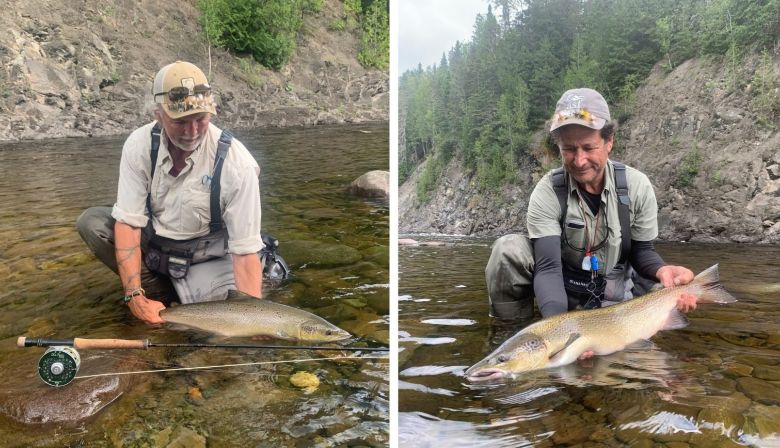
Ray notes:
Very low water to report from Gaspésie. The Bonaventure showed her bones under relentless sun and no rain for weeks. Nevertheless, a few spunky grilse were still taking bombers. Angling companion, Matt Miller, and I were fortunate to hook and land a handful of willing grilse out of Camp Bonaventure, despite persistent low water conditions.

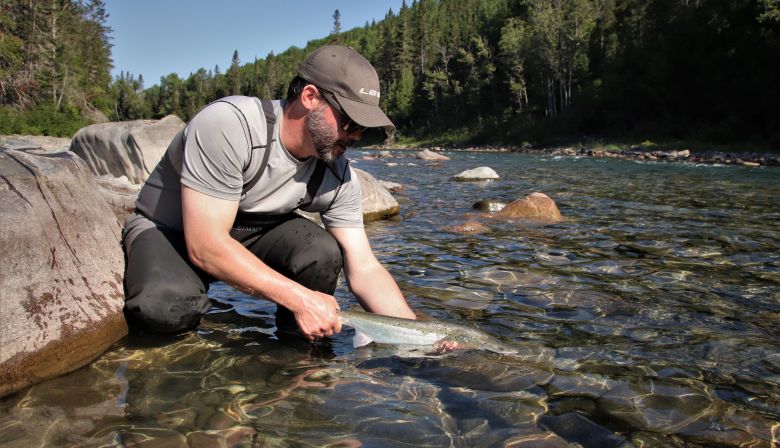
Conditions have been excellent province-wide for the month of August, with 40mm of rain falling weekly since late July. However, despite great water levels, the warm water protocols have kicked in this week due to the high temps over the weekend.
Angling restrictions are in effect for the following rivers: Miramichi | Restigouche | Nepisiguit
From the Miramichi, ASF’s Robert Otto notes:
Recent wet weather has helped to improve water levels and temperatures after a weekend of hot weather that raised water temperatures. Higher than normal numbers of large salmon continue to be present in the system with fish being hooked over the last few days. Current conditions bode well for the remainder of the salmon season.
ASF Director, Edward Shugrue III commented on Restigouche salmon returns:
June was roughly 4x year-over-year with excellent water levels. Water down a fair bit in July but still clear and cool with solid numbers and some great dry-fly fishing.
Robert Kryszko, Special Research and Programs Coordinator, shares respecting the Nepisiguit counting fence:
As of August 24, 2022, the salmon counting fence has processed 50 salmon and 15 grilse.
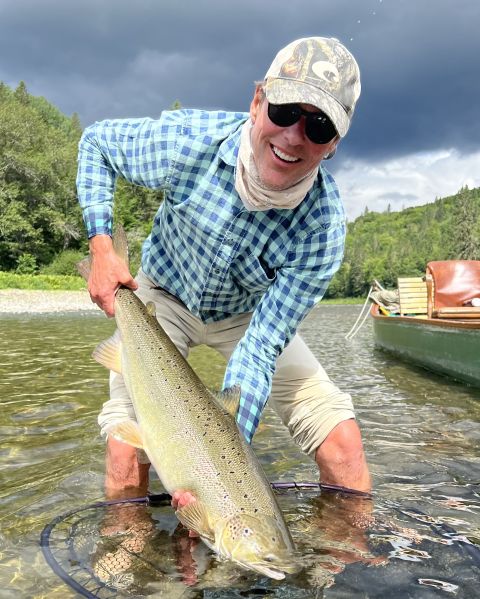
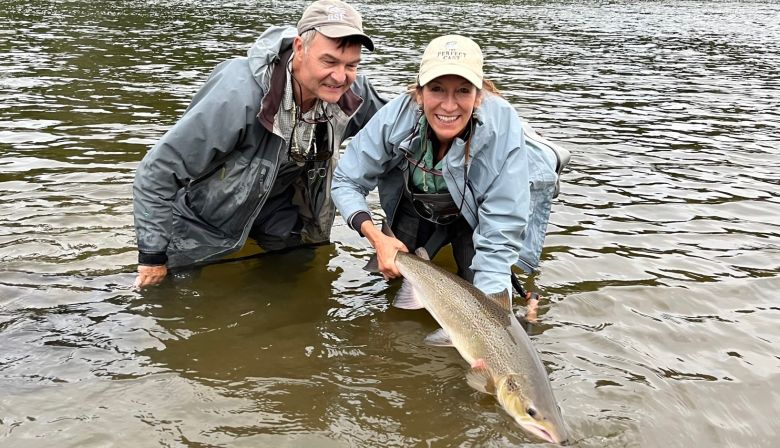
C.D. Clarke reflects on the season thus far:
2022 has been a fantastic salmon season for Tracey and I. From what we have observed and heard, it has been good almost everywhere, even “across the pond” in Norway.
We arrived early to the Gaspé on June 12th and the salmon were already in the Bonaventure in good numbers. We floated the Bonnie quite a few times on our own and found fish every trip. The Petite Cascapédia was good too.
Later in June we were invited for a few days on the Upsalquitch. We caught fish, but not as many as we would have expected given near perfect water conditions. It may have been that the salmon were moving through the system too quickly, and not holding in the pools we were fishing for very long. It was hit or miss. Either we hooked several fish in a session, or we were completely blanked.
On the week of August 7th, we had wonderful fishing at Kedgwick Lodge on the Restigouche. I’ve always said that you need a bit of rain and cooler weather to have good fishing in August. At that time, the fish are always present in good numbers in the better pools but they have been in the river a long time, and can be pretty lock-jawed without something to stir them up. We had both rain and cooler weather along with quite a few cloudy days and the fish definitely woke up.
Our group of 6 rods (including fellow ASF director Will Smart) had 3 to 8 salmon each day, and 8 of those were over 20 pounds. Tracey stole the show with a spectacular 35-pound hen the last night!
It was wonderful to see a river full of fish and conditions that were keeping them prime for spawning this fall. Fingers crossed that things stay that way for the rest of the season.
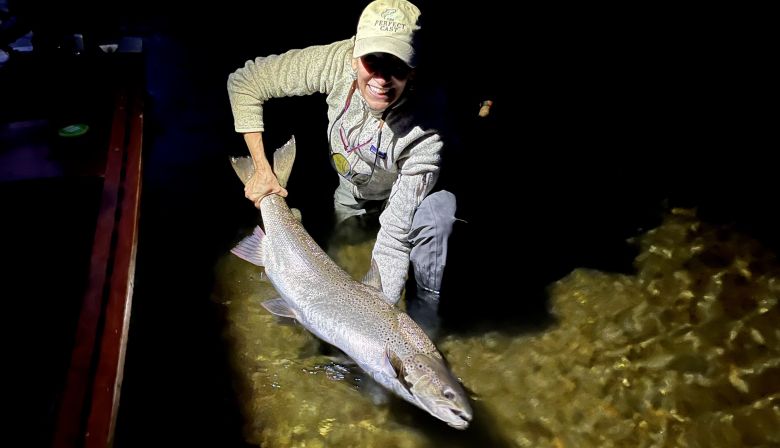
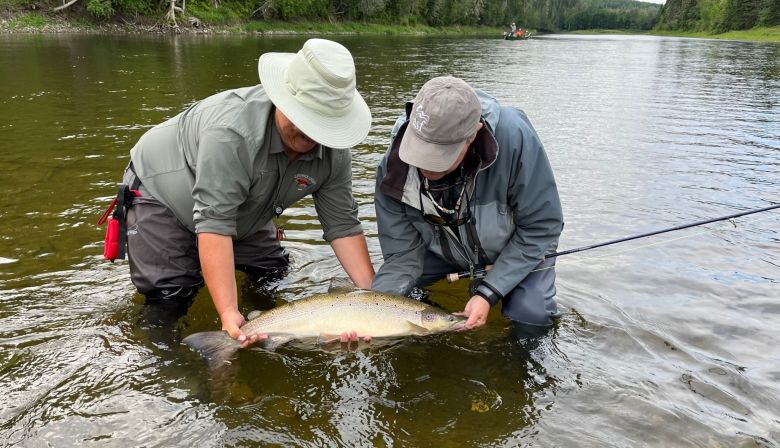
Jacquet River
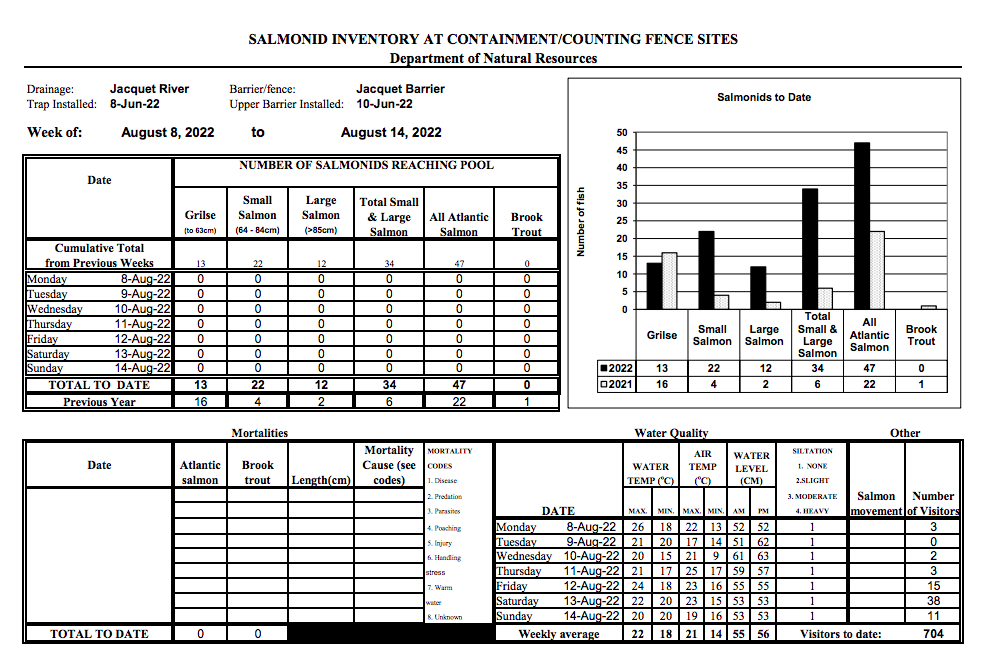
Dungarvon River
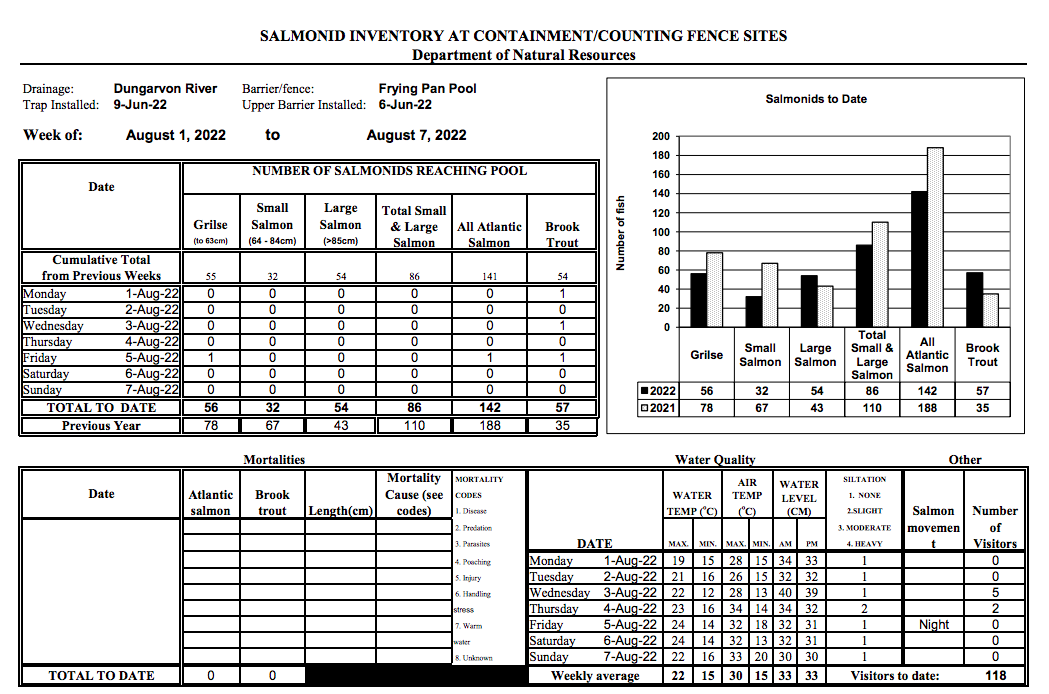
Northwest Miramichi River
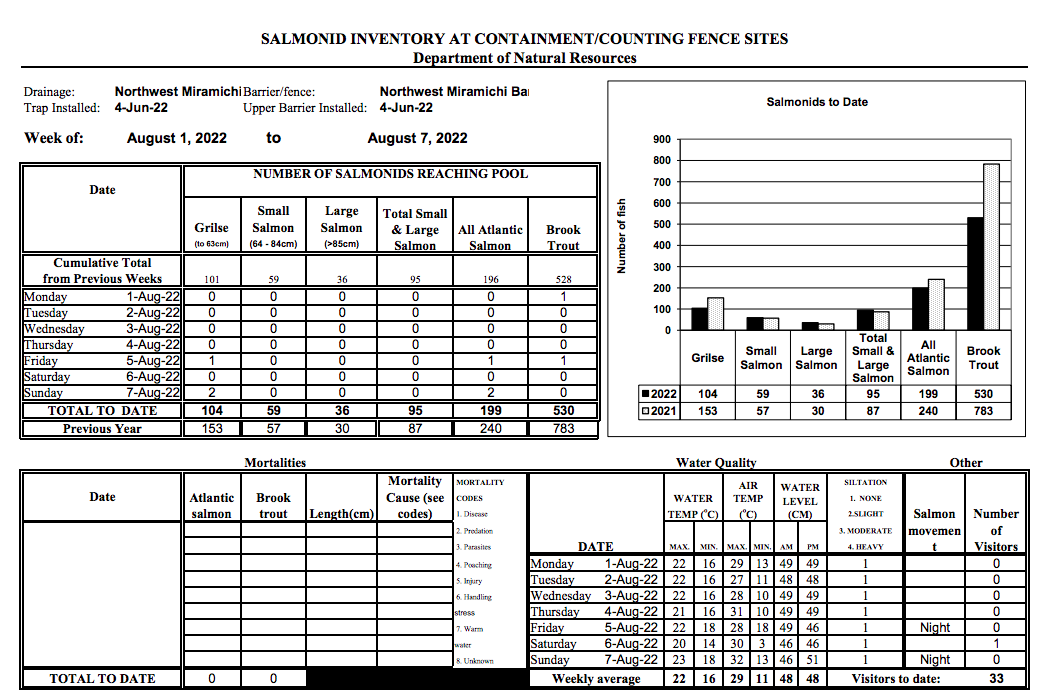

The heat wave impacting central and southern Europe has not been experienced in northern Scandinavia, and the salmon fishing on the Alta in Norway, has continued to be excellent throughout the summer. The Alta usually has a fall run that starts in late August, and I was told last week that it has already begun. I am in back in Norway now and look forward to good fishing but regardless of the fish, it’s always a pleasure and adventure just being here.
